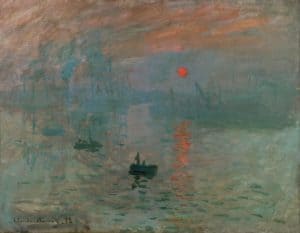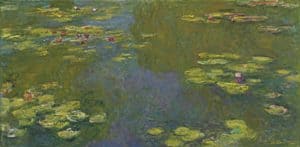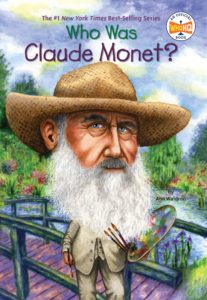As I mentioned in my post about Shakespeare, I’ve spent countless hours watching football and downing cheap lagers. That said, I occasionally like to pretend I’m cultured—you know, go to the orchestra (to catch a nap) or check out the art museum (especially the café). As such, I feel equipped to answer the Who was Claude Monet? question. Here’s a 10-number answer, guided by a book that does a more thorough job.
1840
The year Monet was born (in Paris). At age five, his family moved to Le Havre, a port city on France’s northern coast, where Eugène Boudin introduced him to oil painting en plein air (outdoors). Monet returned to Paris at age 18 and enrolled in classes at the Académie Suisse, an art school where he would befriend Camille Pissarro.
1861
The year Monet joined the French army. Stationed in Algeria, Monet’s planned seven-year stint was cut short after two years due to typhoid fever. After making a payment that obviated the need to resume his military service, he returned to Paris to take classes at Charles Gleyre’s art studio. There, he met the likes of Pierre-Auguste Renoir, Alfred Sisley, and Frédéric Bazille.
1870
The year Monet briefly moved to London and then the Netherlands to avoid military service in the Franco-Prussian War. (Bazille was killed in combat during the conflict.) After returning to France in 1871, travel would remain a part of Monet’s life, evidenced by works portraying scenes from London and Venice.
1874
The year Monet and some of his friends—after frequently having their works rejected by the Salon, a premier art exhibition in Paris—held their own show. Among the paintings on display was Monet’s work depicting the port of Le Havre entitled Impression, soleil levant (Impression, Sunrise). Have a look.

In keeping with that title, critics—of which there were many—derisively labeled the artists as Impressionists. The term was actually embraced by the artists, and Impressionism came to refer to the movement that captured daily life through light and color, often using small and visible brushstrokes, avoiding defined lines, and prominently featuring the outdoors.
1883
The year Monet moved to a village on the Seine River northwest of Paris called Giverny. He would spend the rest of his life there, developing a passion for his approximately 2.5-acre garden and inspiring a colony of American artists hoping to learn from the master.
2
The number of wives and children that Monet had. His first wife, Camille—the subject of numerous paintings—gave birth to their first child in 1867. The next year, struggling through financial hardship, Monet attempted suicide by drowning himself in the Seine River. A second child was born in 1878, though Camille sadly passed away about 18 months later. Monet remarried in 1892, acquiring six stepchildren in the process.
70
An estimate of the number of years that Monet smoked. The habit was a factor in the cataracts that affected his vision and thus impacted his later work. Smoking also ultimately contributed to his death (see below).
1926
The year Monet died (in Giverny) as a result of lung cancer. Fortunately, despite many hardships along the way, he died a wealthy and renowned man.
2,500
A crude estimate of the number of works attributed to Monet. The figure doesn’t include works that he destroyed or that were lost. It does, however, include several series—multiple paintings of the same subject designed to capture the effect of sunlight, time of day, and weather—the most iconic of which is probably the Water Lilies series, based on a pond in his garden. Here’s a look at an example.

You may have to stick to prints on these as a couple originals from the series have sold for upward of $80 million each.
500,000
The number of yearly visitors to Monet’s house and garden, restored as a museum after years of neglect. Giverny is also home to a separate Museum of Impressionism.
So who was Claude Monet? Given that you’re unlikely to remember the above (if you even read it), just go with this—he was one of those French Impressionist painters whose stuff you saw at that one museum before you hit the café.

2 Responses
Very nice article indeed with facts and sense of humor.
Thank you!